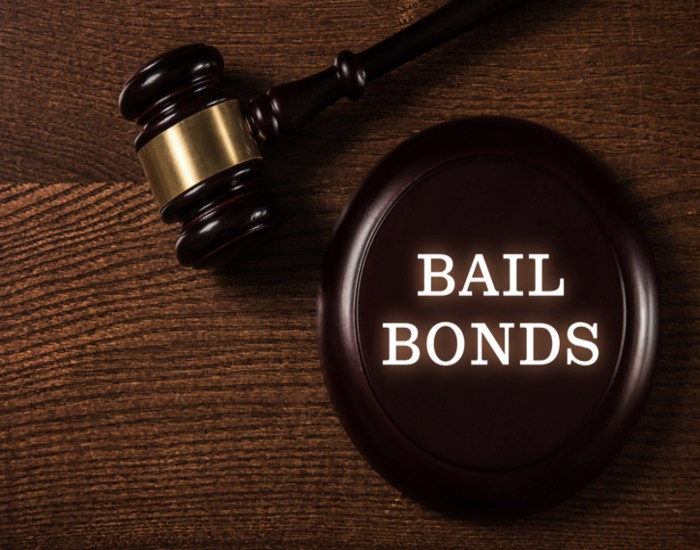A Comprehensive Look at the Bail Bonds Process in Los Angeles
A Comprehensive Look at the Bail Bonds Process in Los Angeles
Blog Article
How Bail Bonds Job: An Extensive Summary
Bail bonds play a crucial duty in the legal procedure by providing a system for individuals to safeguard their release from safekeeping while awaiting test. Understanding the complexities of how bail bonds operate, including the roles of courts, bail bondsmen, and the various fees included, can be crucial for anyone navigating this complex system.
What Are Bail Bonds?
Bail bonds are typically used in the criminal justice system as a monetary assurance that an accused individual will show up in court as called for. When an individual is detained, a judge might set a bail amount based on numerous elements, including the seriousness of the offense, the offender's criminal history, and the danger of trip. If the charged can not afford the bail amount, they might seek the assistance of a bail bondsman.
A bail bond is a contract between the offender, the bondsman, and the court, guaranteeing that the defendant will certainly meet their legal commitments. In exchange for a cost, typically a percent of the total bail quantity, the bondsman supplies the court with a surety that ensures the bail. If the implicated falls short to appear in court, the bondsman is responsible for paying the complete bail total up to the court, which might lead them to pursue the accused for recovery.
Bail bonds serve to help with the release of people awaiting trial, permitting them to maintain their employment and household duties while making sure conformity with court looks. This system is essential to balancing the legal rights of the implicated with the passions of public safety and security and judicial honesty.
The Bail Process Clarified
After recognizing the role of bail bonds in the criminal justice system, it is essential to detail the bail procedure itself. When an individual is jailed and taken into custody, the bail procedure starts. Adhering to the apprehension, the offender is usually brought before a judge for a first hearing, where the court will identify whether to grant bail and set the amount.
If bail is given, the accused has a number of options to safeguard their release. They might pay the full bail amount in cash money, which is returned upon the completion of their court obligations. The accused can look for the support of a bail bondsman, that bills a non-refundable cost-- normally a percentage of the overall bail amount-- to post bail on their part.
Once bail is posted, the offender is released from custody with the understanding that they should participate in all set up court appearances. Failing to appear can cause the forfeit of the bail and additional legal repercussions. The procedure wraps up when the situation is fixed, at which point the bail is either returned or retained by the bondsman as settlement for their solutions.

Types of Bail Bonds
Many choices exist when it involves safeguarding a launch from guardianship with bail bonds. Understanding the different types can help defendants and their families make educated choices.
One of the most common kind is the surety bond, which involves a third-party bail bondsmansman who assures the full bail quantity to the court for a non-refundable charge, normally around 10% of the find more information bail quantity. This option is commonly utilized due to its accessibility for people who might not have the monetary means to pay the complete bail upfront.
An additional type is the cash bond, where the offender or a co-signer pays the complete bail amount in cash money directly to the court. Upon effective conclusion of the situation, the funds are reimbursed, minus any type of applicable charges.

Finally, migration bonds are particularly developed for people detained by migration authorities, facilitating their launch while they wait for legal procedures. Each kind of bail bond serves unique objectives, dealing with different circumstances and needs within the legal system.
Variables Affecting Bail Expenses
Numerous key aspects affect the total cost of bail, establishing just how much an offender or their household might need to spend for launch. One of the main aspects is the severity of the charges. Felony charges normally result in higher bail amounts contrasted to misdemeanors as a result of the perceived risk of trip and the potential consequences of the violation.

Courts might consider a defendant's earnings and possessions when establishing bail, possibly leading to higher prices for those with higher economic sources. If a bond bondsman regards a greater risk, they may set a higher costs, additional increasing the prices connected Find Out More with protecting a bail bond.
Obligations of the Indemnitor
Once bail has actually been secured, the obligations of the indemnitor, or the individual who consents to back the bail bond, entered into play. The indemnitor is largely accountable for guaranteeing that the accused goes to all set up court appearances. Failure to do so may result in the loss of the bail bond and potential lawful effects for the indemnitor.
Additionally, the indemnitor is bound to pay back the bail bond firm the sum total of the bond if the accused fails to appear in court. This includes any type of prices or fees incurred by the bail representative in recouping the offender, which might even more rise the financial concern on the indemnitor.
The indemnitor has to likewise maintain open interaction with both the offender and the bail bondsman, giving any necessary updates associated to the defendant's situation. It is crucial for the indemnitor to remain conscious of the legal obligations and effects connected with the bail bond, as ignorance might result in unexpected responsibilities.
Verdict
In summary, bail bonds act as a crucial device within the criminal justice system, facilitating the launch of accuseds while ensuring their appearance in court. Comprehending the various kinds of bail bonds, the ins and outs of the bail procedure, and the variables influencing bail costs is important for navigating this complicated landscape. Furthermore, understanding of the responsibilities birthed by the indemnitor highlights the significance of notified decision-making when involving with bail bond solutions.
Recognizing the ins and outs of how bail bonds work, including the functions of courts, bail bondsmen, and the various fees entailed, can be vital for any person browsing this complicated system.After comprehending the role of bail bonds in the criminal justice system, it is crucial to detail the bail procedure itself. The offender can look for the assistance of a bail bondsman, who bills a non-refundable charge-- generally a percent of the total bail quantity-- to upload bail on their behalf.
If a bail bondsman perceives a greater risk, they might establish a greater costs, more enhancing the costs connected with securing a bail bond. Recognizing the numerous types of bail bonds, the details of the bail process, and the aspects influencing bail expenses is vital for navigating this facility landscape.
Report this page